Contents
In red and black hawthorn, the difference lies in the species and color of the fruit. Berries may not even be frankly black. Often the word “black” refers only to the darker color of the skin, which still remains red. In the case of hawthorn, both are true. This genus includes plants with black, maroon, and red berries.
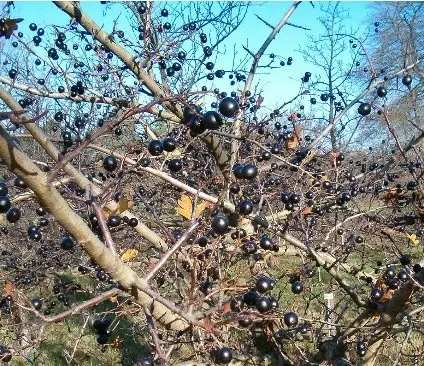
Varieties of chokeberry hawthorn
If you approach from the point of view of a biologist, there are no varieties of hawthorn at all. There are cultivated forms that differ from wild relatives in fruit size. All other features are the same. “Black” varieties were “lucky” even less. They do not even have cultivated forms. Therefore, it is impossible to talk about varieties. But there are many species of hawthorn with black or very dark red fruits in the genus of these trees. Some are very rare, others grow wild in the Americas. In Eurasia, there are 19 varieties with black fruits. Not all of them have medicinal value. Dzungarian was described only by one cultivated tree of unknown origin. Therefore, it is not even clear whether such a species really exists or is it a random hybrid.
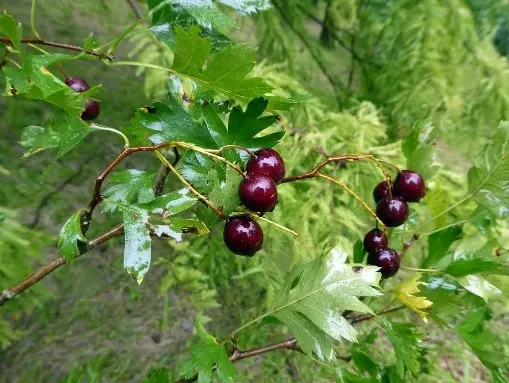
Dzungarian hawthorn Crataegus ×dsungarica
On the territory of Our Country, 4 types of hawthorns with black berries grow:
- five-petal (C. pentagyna);
- Caucasian (C. caucasica);
- chlorosárca (C. chlorosárca);
- Maximowicz (C. maximowiczii).
In Central Asia, the Songhar black hawthorn (Crataegus songarica) grows, and in the European part of Eurasia, the chokeberry bush is simply and unpretentiously called black (C. nigra).
Pentapetal
The same plant is considered Crimean. It has several additional -language names:
- chokeberry;
- Colchis;
- Five-column;
- Hawthorn Klokov.
Although this variety of black hawthorn is often called the Crimean hawthorn, in fact it is distributed throughout Our Country, Ukraine, Hungary, Western Asia and the Balkan Peninsula. Places of growth – forest edges. In the Caucasus, it grows in the middle forest zone.
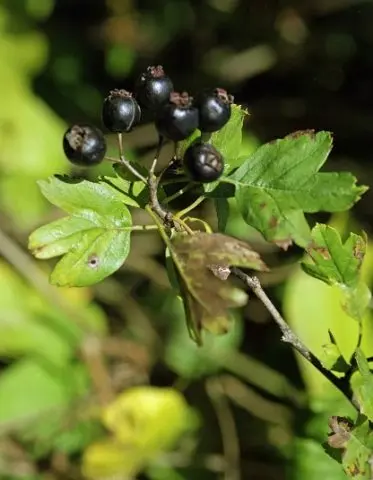
The tree is medium. The usual height is 3-8 m. It can grow up to 12 m. The bark of old branches is gray. The spines are short and sparse. The upper side of the leaves is a shiny dark green. Below – duller, pubescent.
Inflorescences up to 10 cm in diameter, with many small flowers. Petals are white. Blooms in May-June. The fruits are black, with an average diameter of 1 cm. The color of the skin can be purple-black with a bluish bloom. There is little pulp, since the species is not cultivated. Bones in each “apple” 3-5. Fruits in August-September.
Hybrid drupes are darker in color than regular red hawthorn. “Ebony” wood is often used for decorative purposes. There is no reliable data on the healing qualities of black hawthorn, but hybrids can be used for medical purposes.
2 hybrids are cultivated on territory:
- Lambert’s hawthorn (C. lambertiana) – a hybrid of five-petal C. pentagyna with blood-red C. sanguinea;
- winter (C. hiemalis) – a hybrid with hawthorn (C. crus-galli).
For treatment, Lambert’s hawthorn berries are used. This is a dark red variety.
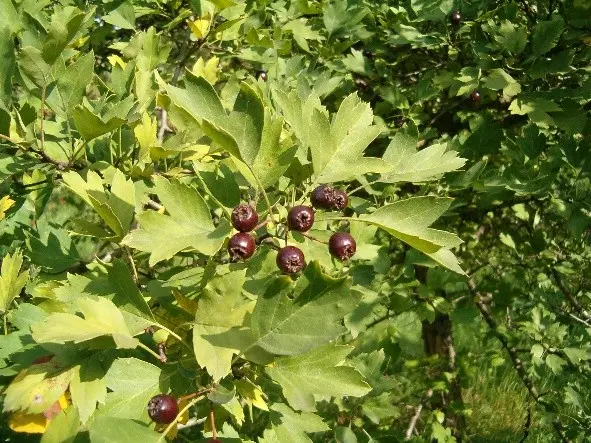
Caucasian
Endemic of the Caucasus. Grows on rocky slopes among other shrubs. The form of this plant is a shrub 2-3 m high. Sometimes it reaches 5 m. If the bush has grown into a tree-like form, it can be up to 7 m high. The branches are dark brown, there are no thorns.
The foliage is deep green, lighter underneath. Leaves ovate, dull. The size of the upper leaves is 6×6,5 cm. The inflorescences are equal in size to the leaves and consist of 5-15 flowers. Blooms in May. Drupes 10-13 cm in size. The color in technical maturity is dark brown. Ripe berries are black-violet with light speckles. The flesh is yellow. Fruiting begins in October.
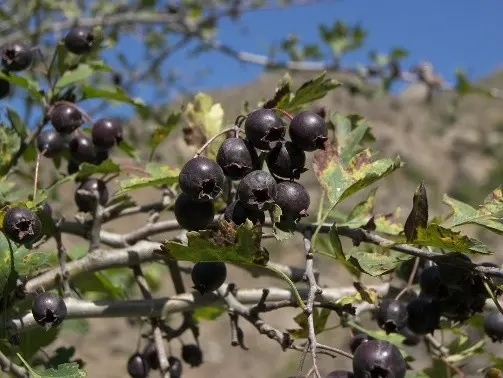
green meat
Asian variety, the range of which captures Kamchatka, Sakhalin, Primorye and Japan. It grows on the edges of forests and dry terraces of rivers. There are single trees, a maximum of 2-3 plants.
Height up to 6 m. The bark is gray or yellowish-brown. Young shoots are dark purple. Spines up to 1,5 cm long.
The diameter of the inflorescences is 2,5-6 cm. Flowering time is late May-early June. The fruits are rounded, up to 1 cm in diameter. In the mature state, the skin color is black with a wax coating. The flesh is greenish. In the immature state, the drupes are red. Bones in the “apple” 4-5 pieces. Fruiting: August-September.
Trees are used in landscape design to decorate the garden. But the green-meat variety is used much less frequently than the European black hawthorn (Crataegus nigra) that replaces it.
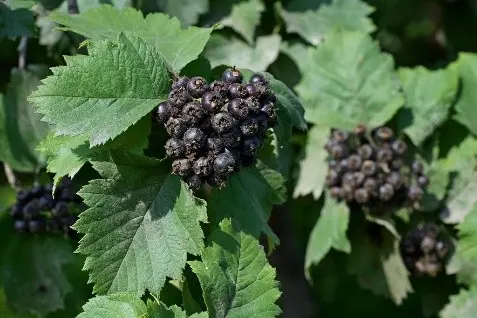
Hawthorn Maximovich
Grows as a tree or shrub. Range: Eastern Siberia and the Far East. Able to grow along riverbeds, flood meadows, forest edges and dry mountain slopes. Grows as single trees. Prefers oak-deciduous forests.
Height up to 7 m. The bark is dark brown or brown-gray. Purple spines are rare, but can be strong and up to 3,5 cm long.
Leaves ovate, up to 13 cm long, up to 10 cm wide. Inflorescence diameter 5 cm. Flowers with white petals 1,5 cm in diameter. Flowering May-June.
The fruits are round, up to 1 cm in diameter. Unripe hairy. When ripe, the pile falls off. Fruiting from August to September.
Black shrub is called conditionally. The fruits are dark red. In this case, a pronounced free treatment with the designation of colors. In the photo of Maksimovich’s hawthorn, not black, but red fruits are visible.
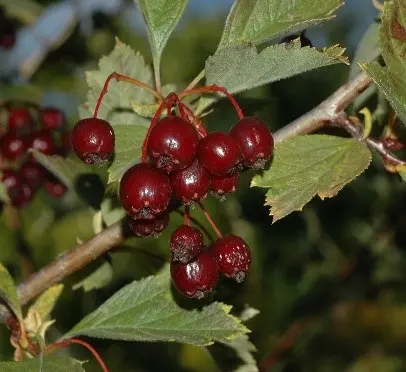
What is the difference between chokeberry and red hawthorn
The classification of hawthorn is very difficult due to the fact that different breeds easily hybridize without human help. Accordingly, the taste characteristics of red and black berries can differ significantly even with the same skin color. Externally, the berries of black and red species differ only in skin color. There may be differences in fruit size. But the size does not depend on the color of the skin, but on the breed of the plant.
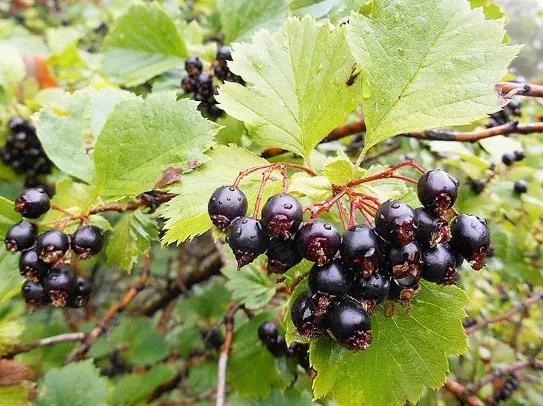
There are no differences in winter hardiness and drought resistance in these plants either, if their ranges intersect. One can definitely say something only about endemic varieties. For example, about Caucasian. This plant does not have enough cold resistance to be grown in the Siberian region.
When planting bushes and trees in the garden, you need to take into account their natural habitat. For decorative design, you can plant breeds with red and black fruits originating from the same region.
When growing, none of the species also causes problems. Both “red” and “black” breeds reproduce well by seeds, cuttings and layering. The seed method takes a very long time. It is easier to propagate representatives of the genus by cuttings.
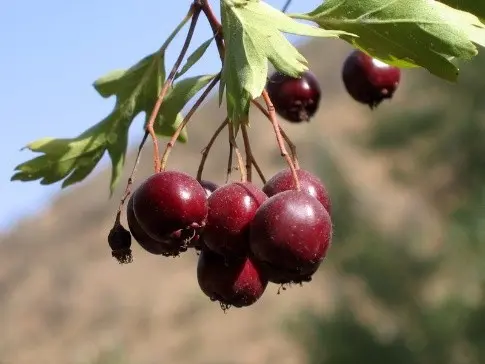
What is the difference between black hawthorn and red hawthorn: a comparison of useful properties
Special studies on the medicinal properties of black hawthorn compared to red hawthorn have not been conducted. You can find recommendations to use only the five-pistil type as a remedy. But both red and black hawthorns are moderately poisonous.
No superiority of black over red or vice versa was noted. One can only assume that black fruits better relieve inflammation in the gastrointestinal tract and improve bowel function due to the higher content of anthocyanin plant pigments in the peel. But red berries also contain anthocyanins, albeit in smaller quantities.
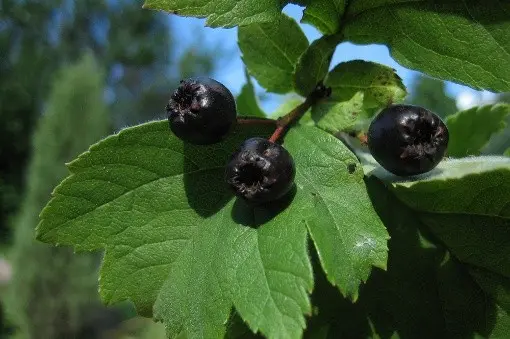
What can be cooked from black hawthorn
From black berries, you can cook everything that is made from red ones:
- jam;
- tinctures;
- decoctions;
- liqueurs;
- marshmallow;
- candies;
- fillings for pies;
- other.
It can also be eaten fresh. The main thing is not to overdo it with the dose. If you want fruit and berry preparations, it is better to use elderberry – a black berry that even looks like a hawthorn. This plant has long been used as a common food crop. Not only blanks are made from it, but also juices that can be consumed without restrictions.
Conclusion
Hawthorn red and black: there is no difference, if you do not take into account the color of the berries. The differences between plants are so insignificant that their classification can be revised. Such light hybridization, as in plants of this genus, may indicate that they are in fact only subspecies.









